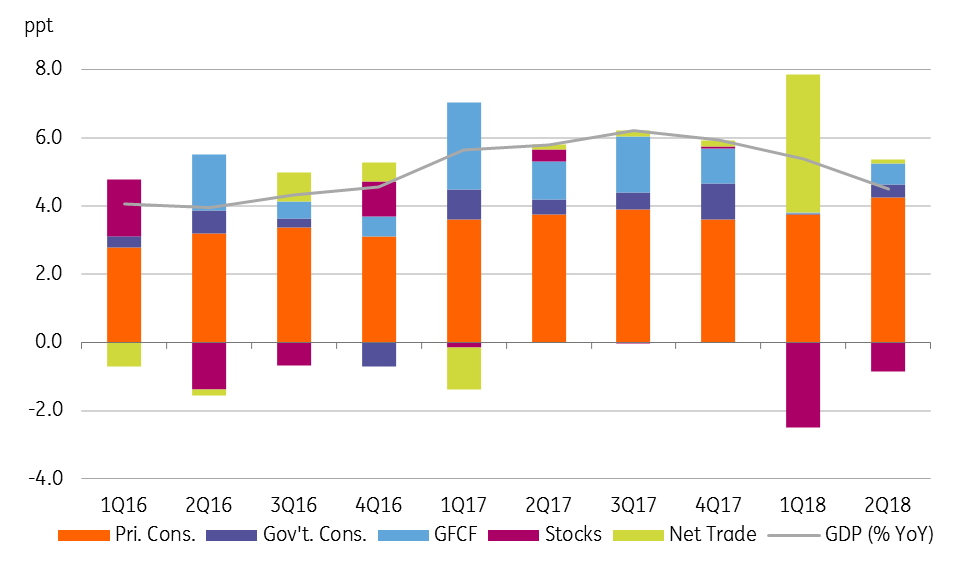Malaysia: A huge downside GDP miss in the second quarter
We have cut our 2018 growth forecast to 4.5% from 5.2%. Slowing growth and low inflation reinforce our view that the central bank (BNM) will keep monetary policy on hold over the remainder of the year. Things are slowly turning sour for the Malaysian ringgit, keeping USD/MYR on track to meet our 4.35 forecast for end-2018
| 4.5% |
GDP growth in 2Q |
| Lower than expected | |
Net exports dent GDP growth in 2Q18
Malaysia’s GDP growth slowed sharply to 4.5% year-on-year in the second quarter from 5.4% in the first. We expected 5.2%, only a modest decline and in line with consensus.
Looking at the breakdown, weak net exports were the main source of downside GDP surprise, contributing only 0.1 percentage point (ppt) to GDP growth as against 4ppt contribution in the previous quarter (see figure). As such, domestic demand returned to the driving seat, led by a 4.3ppt private consumption contribution, up from 3.7ppt in 1Q, while government consumption and fixed capital formation also contributed more than in the previous quarter. This left inventory as a net drag on GDP growth of 0.9ppt.
On the industry side, strong exports supported manufacturing growth, but services remained the main force behind GDP growth. Finance Minister Lim Guan Eng sees 2018 GDP growth at about 5%. The central bank (BNM) cut its forecast today to 5.0% from 5.5-6.0%.
Sources of year-on-year GDP growth

Downgrade of 2018 growth forecast
The weak 2Q GDP report dents our full-year growth forecast. A month ago we revised it to 5.2% from 5.5%. We are now revising it still further to 4.5% as the global trade war will weigh on exports for the rest of the year, and the tight fiscal stance will limit government spending. On the flip side, the GST removal, low inflation, and improved real incomes of households should support consumer spending.
| MYR 3.9bn |
Current surplus in 2QDown from MYR8.8bn a year ago |
Weakening external payments
Reinforcing the weak external sector contribution to GDP growth, the balance of payments data for 2Q (also released alongside GDP data today) showed a significant narrowing in the current account surplus to MYR 3.9bn from MYR 8.8bn a year ago. The goods trade surplus remained strong though, as was evident from the monthly customs trade data. We have also cut our current account surplus forecast for the year to 2% of GDP from 3.5%, which will be a narrowing from 3% in 2017.
Policy implications
Slowing growth and low inflation reinforce our view that the central bank (BNM) will keep monetary policy on hold over the remainder of the year. Things are turning sour for the Malaysian ringgit (MYR), Asia’s outperforming currency so far. The contagion-effect of the US-China trade war is behind our view of the USD/MYR rate rising up to 4.35 by end-2018 (spot 4.10). Until today we were uncomfortable about our view due to continued MYR outperformance in the recent emerging market currency rout. But today’s data raises our confidence in our forecast.
Economic forecast summary

Download
Download article
20 August 2018
Good MornING Asia - 20 August 2018 This bundle contains {bundle_entries}{/bundle_entries} articles"THINK Outside" is a collection of specially commissioned content from third-party sources, such as economic think-tanks and academic institutions, that ING deems reliable and from non-research departments within ING. ING Bank N.V. ("ING") uses these sources to expand the range of opinions you can find on the THINK website. Some of these sources are not the property of or managed by ING, and therefore ING cannot always guarantee the correctness, completeness, actuality and quality of such sources, nor the availability at any given time of the data and information provided, and ING cannot accept any liability in this respect, insofar as this is permissible pursuant to the applicable laws and regulations.
This publication does not necessarily reflect the ING house view. This publication has been prepared solely for information purposes without regard to any particular user's investment objectives, financial situation, or means. The information in the publication is not an investment recommendation and it is not investment, legal or tax advice or an offer or solicitation to purchase or sell any financial instrument. Reasonable care has been taken to ensure that this publication is not untrue or misleading when published, but ING does not represent that it is accurate or complete. ING does not accept any liability for any direct, indirect or consequential loss arising from any use of this publication. Unless otherwise stated, any views, forecasts, or estimates are solely those of the author(s), as of the date of the publication and are subject to change without notice.
The distribution of this publication may be restricted by law or regulation in different jurisdictions and persons into whose possession this publication comes should inform themselves about, and observe, such restrictions.
Copyright and database rights protection exists in this report and it may not be reproduced, distributed or published by any person for any purpose without the prior express consent of ING. All rights are reserved.
ING Bank N.V. is authorised by the Dutch Central Bank and supervised by the European Central Bank (ECB), the Dutch Central Bank (DNB) and the Dutch Authority for the Financial Markets (AFM). ING Bank N.V. is incorporated in the Netherlands (Trade Register no. 33031431 Amsterdam).